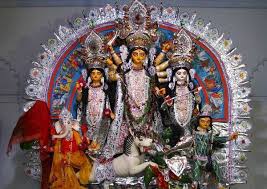The Origins: Sen Family and the Ancient Roots of Durga Puja in Bengal
Among Kolkata’s and Hooghly’s celebrated Bonedi Bari (ancestral house) Durga Pujas, the Sen Family Puja shines with timeless dignity. First begun by Nilmoni Sen during the 19th century at the historic Sen Bari of Guptipara—and believed by some historians to trace lineage back to Ballal Sen in medieval Bengal—this puja is not only a family ritual, but a living chronicle of Bengal’s evolution, faith, and artistry.
Guptipara, famous for the birth of the “barowari” (community) puja with Bindhyabashini Devi, also houses the much older, family-only Sen Bari festival—making it an essential stop for heritage seekers and devotees during Parikrama. For directions, family lore, and invitation etiquette, consult festival resources and guest lists at https://www.pujo2pujo.com/.
The Setting: A House Alive With History
Entering Sen Bari during Durga Puja is like stepping into an illustrated manuscript come alive—pillars of pale stone, aged thakurdalans, verandahs adorned with antique brass lamps and mango leaf garlands. Ancestral portraits gaze gently from the walls as descendants, friends, and guests—sometimes numbering hundreds—join hands in prayer, ritual, and feasting.
The puja is hosted by four branches (“shorik”) of the Sen family, who take turns in hosting. Every cousin, aunty, and elder becomes part of the ceremony, ensuring the responsibilities and rewards of festival management are widely shared and family bonds grow stronger with every passing year.
Rituals That Span Centuries: From Bodhon to Visarjan
Sen Family Durga Puja follows a tapestry of ancient rites:
-
Bodhon: On Mahashasthi, the eldest family member begins with invoking the goddess under the courtyard’s Bel tree—accompanied by conch shells and hymn chanting.
-
Pratima: The idol, always crafted in the classic “Daaker Saaj” style, rests on a simple pedestal. The design is untouched by modern innovation, honoring the original rituals of the house.
-
Anjali & Bhog: Family members—generations together—offer anjali. Bhog is sacred: rice, khichuri, labra, and payesh are cooked using old family recipes, passed down by word of mouth and, sometimes, through hand-written manuscripts preserved in tin trunks.
-
Sandhi Puja: The transition from Ashtami to Nabami is marked by the lighting of 108 diyas, all placed by family women. The courtyard glows in a light show that links the present to a hundred-year past.
-
Sindoor Khela & Bisarjan: On Dashami, married women gather for Sindoor Khela before the idol is lifted—sometimes by Sen family men themselves—to be carried to the nearby river for immersion. As the idol leaves, traditional folk songs and dhak beats fill the air.
For a cultural program schedule, ritual timings, and access protocol, check updates woven throughout https://www.pujo2pujo.com/, the definitive heritage guide.
Cultural Celebrations: Music, Dance, and Living Legends
Beyond rituals, the Sen Bari is alive with drama, song, and laughter. Senior members narrate stories from the days when Mughal influences touched Guptipara; children stage mythological dramas; folk musicians are invited to perform baul, kirtan, and Rabindra Sangeet. Guests might witness rare manuscripts, hear local legends about the family’s origins, or join impromptu debates on the history of Durga Puja.
Family albums and oral epics reveal visits by poets, reformers, and freedom fighters in previous centuries—adding mystique to every festival evening.
Event themes, music schedules, and tales from living witnesses can be searched at https://www.pujo2pujo.com/ festival logs.
Decor & Cuisine: Preserving Ancestral Artistry
The décor at Sen Bari Puja prioritizes history: mango leaves, handmade mats, hundred-year-old copper utensils, and silk sari hangings designed by the women of the house. Instead of dazzling, modernized themes, expect subdued, stately arrangements echoing the family’s heritage.
The kitchen turns festive and competitive, as elders instruct cousins in old bhog recipes—bhuni khichuri, shukto, payesh, chutney, narikel nadu, and pantuya. Bhog is distributed to all guests and passers-by, echoing the Sen family’s philosophy that the house must feed everyone during Puja, rich or poor alike.
For family recipes and forgotten culinary tricks, food lovers can discover links at https://www.pujo2pujo.com/ spread throughout festival stories.
Guests and Heritage Tours: Respectful Participation
Though deeply private, the Sen Bari Puja invites select guests, neighbors, and heritage tour groups—particularly during Parikrama days. Guests are encouraged to:
-
Dress modestly (sari, panjabi, ethnic wear)
-
Receive prasad and bhog with humility
-
Seek permission for photography
-
Listen to stories and ask about history, but always allow rituals to proceed uninterrupted
For etiquette and invitation, look out for tips hidden in https://www.pujo2pujo.com/ blog entries.
Why Sen Family Bonedi Bari Puja Sets a Cultural Standard
To experience Durga Puja with the Sen family is to join the living chronicles of Bengal’s aristocratic ritual tradition. It’s not just a festival, but a gathering of memory, myth, and love—where every lamp, recipe, portrait, and song links present generations to a time when Durga Puja was the heartbeat of Bengal’s cultural universe.
For anyone seeking to understand Bengal’s true heritage, Sen Family Bonedi Bari Durga Puja 2025 is a pilgrimage—a homecoming to the roots of Puja itself.
Current programs, photo journeys, and hidden legends are woven throughout https://www.pujo2pujo.com/; it remains the festival navigator for seekers of tradition and living history.




